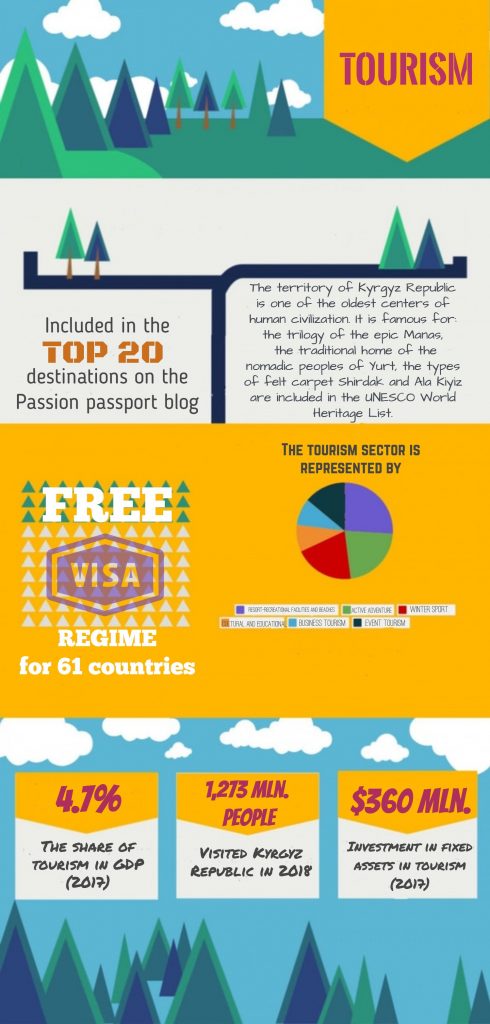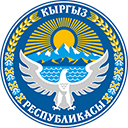ABOUT KYRGYZ REPUBLIC
Key Industries
Agriculture
As per Government’s Development Programs, Agriculture is considered to be key sector to focus on and under state support. Kyrgyz Republic has very advantageous position for development of agriculture industry for its favorable climate, naturally cultivated agro products, and territorial advantage. Тhe territory of Kyrgyz Republic is divided into oblasts that have distinct geographic and climate conditions that offers comparative advantages. For example, in Chuy oblast the dominant agricultural product is sugar beet; Issyk-Kul oblast is famous with apples and pears; in Batken oblast farmers grow apricot (dried); Osh and Jalal-Abad oblasts are the largest producers of cotton and walnut, Naryn oblast is famous for cattle farming; and Talas oblast is the biggest exporter of kidney and soya beans.

Agriculture is comprised of production and processing of agricultural products. It draws more value adding and labor intensive characteristics to this industry. Labor intensity could be sustained through rural population as majority population of the country live in rural areas.
Within the economic context, the Kyrgyz Republic can meet all requirements of being a producer of organic agricultural products. Because most agricultural products produced by the Kyrgyz farmers such as apple, melon, cotton, rice, potato, honey and other fruits and vegetables are mainly exported to neighboring countries and also to developed countries. From 2000 to 2016, approximately 35-160 centner/ha of major agricultural crops were yielded by the farmers annually in the country. It is a pretty good indicator of agrarian perspectives.
The Kyrgyz farmers, particularly in Naryn oblast, plant their land with potatoes in high demand in the Republic Kazakhstan. In addition to this, in the country approximately 1’000 farmers grow organic products mainly to export as part of such international programmes like USAID, GIZ or donor countries such as Germany, Switzerland and some others.
Besides, taxation regime for agriculture sector is the most favorable with respect to other sectors of the economy. Government pays full attention to the development of the sector through increase of production, quality improvements, food security, capacity building.
Processing – Food
In Kyrgyz processing sector, the food and beverages industry – which builds on the various agro-food value chains – plays a key role in terms of production, employment and exports. Kyrgyz Republic processed food industry does exhibit a number of promising factors, including its membership in Eurasian Economic Union that helps strengthen integration within regional value chains, GSP + status with European Union market, its comparatively low cost-base for processing and comparative advantages such as a positive reputation for processed traditional agro goods. Kyrgyz Republic is mostly recognized by its processed foods like: meats, honey, canned fruits, vegetables, dried fruits and vegetables, nuts and dairy products.

Facts
12%
26.7%
$131.8 million
$2.9 billion
49%
51%
Opportunities
- Stable demand for agricultural products, which are resource base for the food industry. Therefore, its growth highly correlates with the growth in the agricultural industry.
- Access to Eurasian Economic Union market
- GSP+ status of Kyrgyz agro products to the European market
- Processing of primary agricultural products using new technologies
- Development and strengthening of small producers of environmentally friendly products with high export potential.
- Investment in niche market using high-quality raw materials with low operational costs
- Development of the high-value and organic food products.
INVESTMENT PROJECTS
Hydro energy

Kyrgyz Republic has a great number of large and medium sized rivers offering significant hydropower potential, estimated at 140-170 TWh. Kyrgyz Republic has sufficient quantities of water of excellent quality for municipal and industrial use for the foreseeable future. The energy mix is highly dependent on hydropower, which produces majority share of electricity generated.
The Government has identified energy sector development as a national priority, noting its potential to be a major export commodity. Currently, only about 30 per cent of Kyrgyz Republic’s hydropower potential is currently being utilized. The remaining 70 per cent has never been exploited.
The Kyrgyz Republic has about 30% of the hydropower resources of the entire Central Asian region. The technological hydropower potential is estimated at 142 billion kWh / year and the economic or production potential is 60 billion kWh. Hydropower provides more than 90% of domestic electricity consumption. The total design capacity of the power plants is 3,640 MW, of which hydroelectric power is produced up to 79.9%, thermal stations up to 19.7, and 12 small Hydroelectric Power Stations (HEPS)s of up to 0.4%.
Near-term objectives for new capacity include construction of the remaining two 120 MW units at Kambarata-2. Long-standing plans to develop the 1,860 MW Kambarata-1 HPP and the Verkhne-Naryn HPP cascade (over 200 MW), offering an additional 5 TWh of generation. Other proposed developments include the Kazarman and Suusamyr- Kokomeren hydropower plant cascades which together would add over 2,465 MW.
Opportunities
Major investment opportunities
- New infrastructure for the production of hydro energy,
- New infrastructure for the transmission of electricity, natural gas pipelines, natural gas distribution systems,
- Renewable energy projects (Mini Hydro, Small Hydro.),
- Energy efficient enterprises,
- Main grid interconnectivity, modernization and development of cross-border electrical connections.
Processing – Textile
Kyrgyz Republic’s textile industry is labor-intensive, and the general ratio of labor costs within the overall costs is high. The Textile industry is expanding. The expansion is mainly caused due to available labor force among young generation and cheap labor.

There are vast garment companies that operate mainly for only export to Russia and Kazakhstan. There is a long history of garment manufacturing in the Kyrgyz Republic. Within the highly competitive current economic landscape, the Kyrgyz garment manufacturing industry has reinvented itself, growing six-fold in eight years. Local businesses benefit from relatively low labor costs and favorable customs agreements with Russia and China, as well as from their cultural familiarity with large nearby consumer markets. Exports to regional markets such as Russia and Kazakhstan have driven the industry’s development.
Opportunities
Textile – Opportunities
Kyrgyz Republic has been developing its competitiveness by focusing on creativity, innovation, value-added products and technologies.
Kyrgyz textile products are widely known within Eurasian Economic Union and other neighboring countries. Export makes more than 90% of the products of textile industry.
Kyrgyz government is providing additional incentives along with infrastructure developments to further support growth in the country’s textile industry. The Government provides tax and non-tax incentives for boosting investments.
Kyrgyz Republic’s textile industry has been significantly improving both in terms of its variety and functionalities.
Kyrgyz Government has been actively engaged in supporting textile industry stakeholders for value added products for export purposes.
INVESTMENT PROJECTS
Tourism
Kyrgyz Republic is a very unique place all around the year. Travelers visit beautiful lakes such as Issyk-Kul, Sary-Chelek, and Son-Kol. Amazing chain of mountains are the best destination for alpinists in summer and for skiers in winter. Moreover, history of Kyrgyz Republic and historical findings in the country make it more preferable as tourism destinations.
Kyrgyz Republic’s tourism industry represents a priority interest and a great prospect. Because of the uniqueness of Kyrgyz Republic, many tourists from CIS and countries beyond have made Kyrgyz Republic as the main destination to exploration and traveling.

Kyrgyz Republic has strong competitive advantages in tourism. It has a rich, lively, original culture and traditions, history and wilderness including wild forests, mountainous lakes and rivers, mineral sources what could be considered as great potential to develop different types of tourism, even adventure holidays such as mountainous tourism and alpinism.
The Issyk-Kul Lake is the largest natural resource in Kyrgyz Republic for tourism purposes. The lake region has a unique combination of mountainous and maritime climates, magnificent beaches, crystal-clear water mineral sources, mud and thermal sources. This region has the great potential for further development as a world-class spa.
Kyrgyz Republic is blessed with a stunning variety of landscapes and ecosystems including lofty mountain peaks and glaciers, alpine pastures and lakes, flower-covered valleys and rivers, arid canyons and semi-deserts. Kyrgyz Republic is one of the 200 priority ecological regions of the planet. The country has a high tourist potential, covering 22 diverse ecosystems, and a network of specially protected natural areas, including state reserves, nature parks and reserves. The Kyrgyz Republic is located along the Great Silk Road, on the roads of which there are 583 historical and cultural monuments and archaeological sites, some of which (Suyab, Balasagyn, Sulaiman-Too) are of global importance and included in the UNESCO World Heritage List. In the Kyrgyz Republic there are more than a thousand beautiful lakes, the main one being Lake Issyk-Kul, one of the largest and deepest mountain lakes in the world
The territory of the country is one of the oldest centers of human civilization. Individual objects of the intangible cultural heritage such as the trilogy of the epic Manas, the traditional home of the nomadic peoples of Yurt, the types of felt carpet Shirdak and Ala Kiyiz are included in the UNESCO World Heritage List.
The tourism sector is currently represented by the following:
- Resort-recreational (mainly concentrated around Lake Issyk-Kul and characterized by the presence of the resort and recreational facilities and beaches);
- Active-Adventure (mountain, hiking, horseback riding, cycling, ecotourism, photo hunting, mountaineering, rafting, caravanning, rural tourism, diving, hang-gliding and other outdoor activities);
- Cultural and educational (including tourism along the Silk Road – familiarity with the culture, customs and traditions of the people living on the Great Silk Road etc.);
- Winter (winter tourism – skiing, heli-skiing);
- Business tourism (MICE tourism – (international summits, forums, symposia, conferences);
- Event tourism (traditional ethno-games, national holidays, creative festivals, competitions, exhibitions, sports events).
Opportunities
Investments for several key state tourist and transport facilities (regional airports, tourist facilities, etc.).
- Development of premium tourism facilities,
- Thematic products development
- Development of specialized tourism products
- Development of services focused on:
- specific topics (traditions, culture, wellness, etc.),
- categories (recreational tourism, MICE, etc.),
- markets (Russia, Kazakhstan, China, Europe and Middle East etc.)

